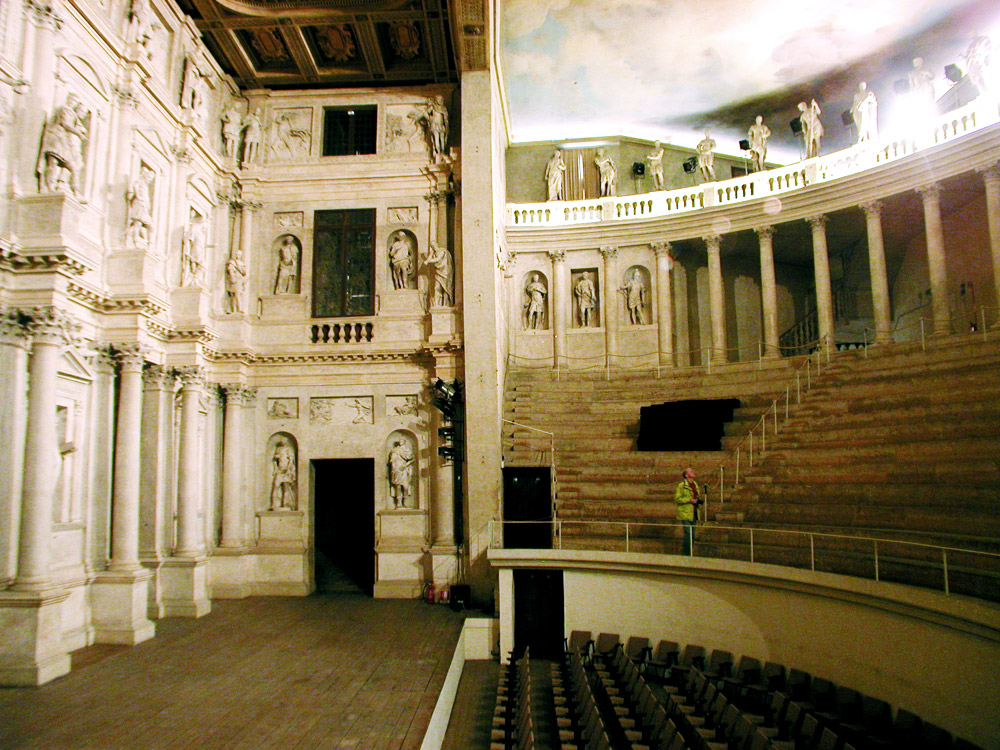 Olympic Theatre
Olympic Theatre
Vicenza is a treasure trove of history. It reached its pinnacle in the Renaissance, in the Venetian period, when an ingenious architect appeared on the scene: Andrea Palladio. His masterwork is the Teatro Olimpico, the oldest theatre building in the western hemisphere, commissioned by the Accademia Olimpica of Vicenza. On 3 March 1585 it was inaugurated with "Oedipus the tyrant" by Sophocles. Today it is a Unesco World Heritage.
We reach the auditorium by passing through two halls designed by Vincenzo Scamozzi, the Odeon and the Antiodeon. The auditorium suggests an antique Roman open-air theatre with a monumental stage wall (scenae frons). The arches in the wall open up to the streets of Thebes, or rather the original wooden stage decorations created by Scamozzi for the very first performance in 1585 and on site unchanged until today. The stage wall features statutes of members of the Academy and reliefs depicting the adventures of Hercules.
In the first months of each year, the Teatro Olimpico hosts concerts of classical music and the festival Vicenza Jazz, whereas in autumn the renowned Ciclo di Spettacoli Classici presents classic drama.
Teatro Olimpico · Piazza Matteotti, 11 · 36100 Vicenza · Tel.: +39 0444 222800 · E-mail: museocivico[at]comune.vicenza.it · www.museicivicivicenza.it · www.olimpicovicenza.it
Visits: Tue-Sun 09:00-17:00
(July and August 10:00 - 18:00).
Closed Mondays and during special events.
Tourist Office: Ufficio Informazione e Accoglienza Turistica
Tel.: +39 0444 320854
iat.vicenza1[at]provincia.vicenza.it
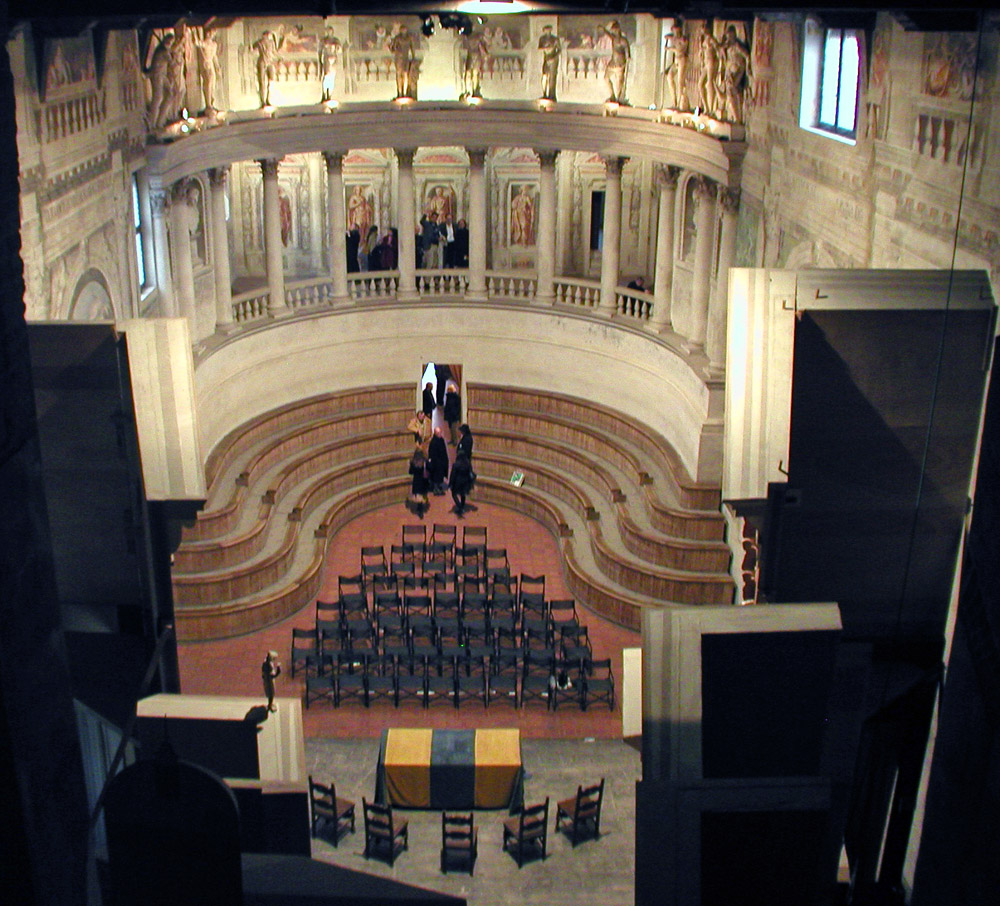 Classical Theatre
Classical Theatre
Sabbioneta, the ideal city, grew from nothing between 1556 and 1591, conceived by the duke Vespasiano Gonzaga Colonna. Together with Mantua it is today a Unesco World Heritage. Here stands the Teatro all’Antica (The Classical Theatre), built between 1588 and 1590 by the architect Vincenzo Scamozzi. It is the first theatre in modern times that was conceived from the start as theatre building, without adapting a pre-existing building.
The wonderful frescoes inside were created by artists from Venice, part of Paolo Veronese’s school, as is evident in the painted spectators above the loggia. Other frescoes and sculptures refer to ancient Rome. The loggia, an early example of a Royal Box, is adorned with twelve elegant columns that support the same number of statues of Olympic gods. The layout of the room is reminiscent of a classical theatre: a semicircle with steps for the audience, a rectangular orchestra and a raised stage with a permanent, three-dimensional stage set – and still without a portal.
Other important buildings in the city: the Garden palace (Palazzo del Giardino), the Gallery of Antiquities (Galleria degli Antichi), the Duke’s Palace (Palazzo Ducale), the synagogue
Teatro all’Antica · Via del Teatro Olimpico, 1 · 46018 Sabbioneta (MN) · Tel: +39 0375 221044 · E-mail: ufficio.turismo[at]comune.sabbioneta.mn.it
Visits: November-March Tue-Sun 9:30-13:00 and 14:30-17:00 / 18:00 (Sun and holidays); April-October Di-So Tue-Sun 9:30-13:00 and 14:30-18:30 / 19:00 (Sun and holidays)
Tourist Office: Pro Loco
Tel.:+39 0375 52039
info[at]sabbioneta.org
www.sabbioneta.org
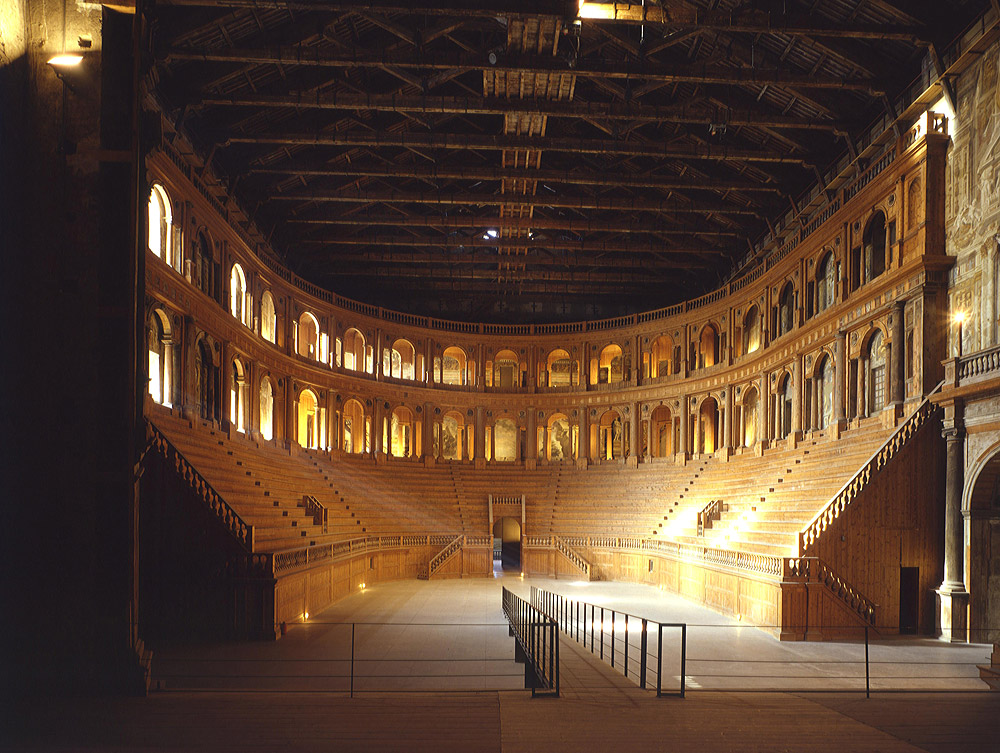 Farnese Theatre
Farnese Theatre
The theatre lies hidden inside the vast Palazzo della Pilotta. It was inserted in 1617-18 by Giovan Battista Aleotti in a spacious hall that had up to that point served as an armoury. The frescos and two triumphal arches transform the interior into a monumental square. It was commissioned by the Duke of Parma, Ranucci I. Farnese, who wanted to celebrate the visit of Cosimo II. Medici and arrange a political marriage. But Cosimo did not show up, and thus the inauguration took place only in 1628 on the occasion of the marriage of Odoardo Farnese and Margherita Medici; on the programme: Monteverdi’s “Mercurio e Marte.”
The theatre was designed for tournament-operas, a mix of opera and fighting. It became a model for Baroque theatre by virtue of its size and a new element: a monumental proscenium that divides the stage (with the first movable scenery in theatre history) and the auditorium. The action on stage could be continued in the arena of the auditorium which could also be filled with water to host sea battles. Performances in the Farnese Theatre were rare and restricted to special occasions. Following an air raid, the wooden interior burnt down in 1944 and was reconstructed in 1956.
Teatro Farnese · Palazzo Pilotta · Piazzale Pilotta 15 · 43100 Parma · Tel. +39 0521 233617/233309 · E-mail: sbsae-pr[at]beniculturali.it · www.gallerianazionaleparma.it
Visits: Tue-Sun 8:30-14:00 (box office closes at 13:30). Closed Mondays and 1 January, 1 May, 25 December
Tourist Office: Ufficio Informazione e Accoglienza Turistica
Tel. +39 0521218889
oppure 0521218855
turismo[at]comune.parma.it
turismo.comune.parma.it
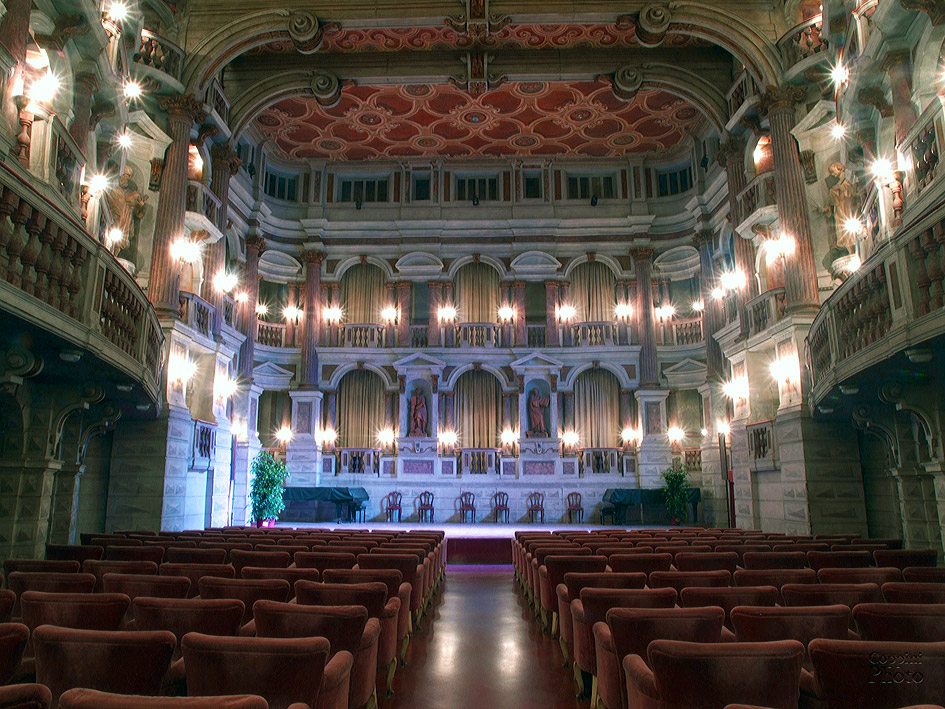 Scientific Theatre
Scientific Theatre
This very special theatre in the city of the Gonzagas, today a Unesco World Heritage, was built to plans of Antonio Galli Bibiena from Parma as a venue for scientific discussions, performances, and concerts. Erected from 1767 to 1769, it features a bell-shaped auditorium. Bibiena, a gifted painter as well as architect, decorated the interior of many boxes himself with monochrome motives. The classicist facade is by Giuseppe Piermarini.
The “Scientific Theatre” (Teatro Scientifico) was inaugurated on 3 December 1769. One month later, the young Wolfgang Amadeus Mozart gave a memorable concert here. Today the theatre is a venue for concerts, music contests, and conferences.
Teatro Scientifico Bibiena · Via Accademia 47 · 46100 Mantova · Tel. +39 0376 327653 · Tel. Administration: +39 0376 338648 · E-mail: sale.comunali[at]domino.comune.mantova.it · www.mumm.mantova.it/interno/schedemumm/teatrobibiena.jsp
Visits: Tue-Sun 9:30-12:30 and 15:00-18:00. Closed on Mondays and during conferences. Other closures: 1 January, 15 August, 25 December
Tourist Office:
Ufficio Informazione e Accoglienza Turistica
Tel.: +39 0376 432 432
info[at]turismo.mantova.it
www.turismo.mantova.it
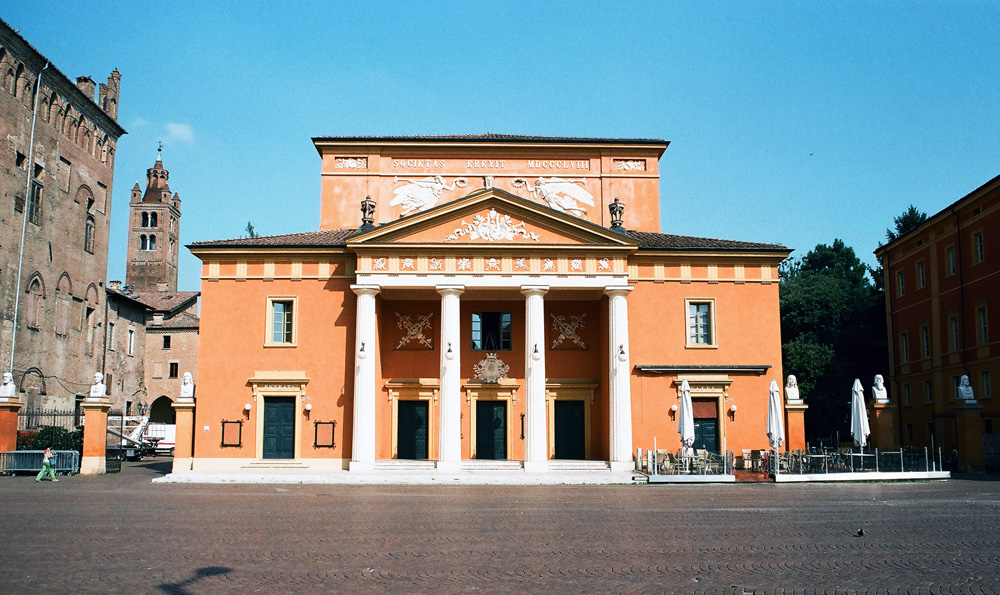 Municipal Theatre
Municipal Theatre
Inaugurated in 1861, the Municipal Theatre in Carpi is an excellent example of an Italian-style theatre: a horseshoe-shaped auditorium continues up the walls with three circles of boxes and a gallery. Including the stalls it offers almost 600 seats. It was a “Society of Box Owners” that entrusted the architect Cesare Costa with the task of erecting a new theatre on the impressive main square, the Piazza dei Martiri. Contrary to the inscription over the portico, the theatre became the property of the city already before the inauguration. It has been entirely preserved since then. The stucco decorations inside were created by local artisans, while the painted ceiling is by Giuseppe Ugolino from Reggio Emilia; he is also believed to be the painter of the famous front curtain for which the most beautiful women in town volunteered as models.
Teatro Comunale · Piazza Martiri, 72 · 41012 Carpi (Mo) · Tel. office: +39 059 649 264 · E-mail: teatro.comunale[at]carpidiem.it · www.carpiediem.it/teatrocomunale
Performances from October to April · Tel. box office: +39 059 649 263 · www.vivaticket.it
Visits: on appointment
Tourist Office:
Ufficio Informazione e Accoglienza Turistica
Tel.: +39 059 649255
iat[at]carpidiem.it
www.turismo.comune.carpi.mo.it
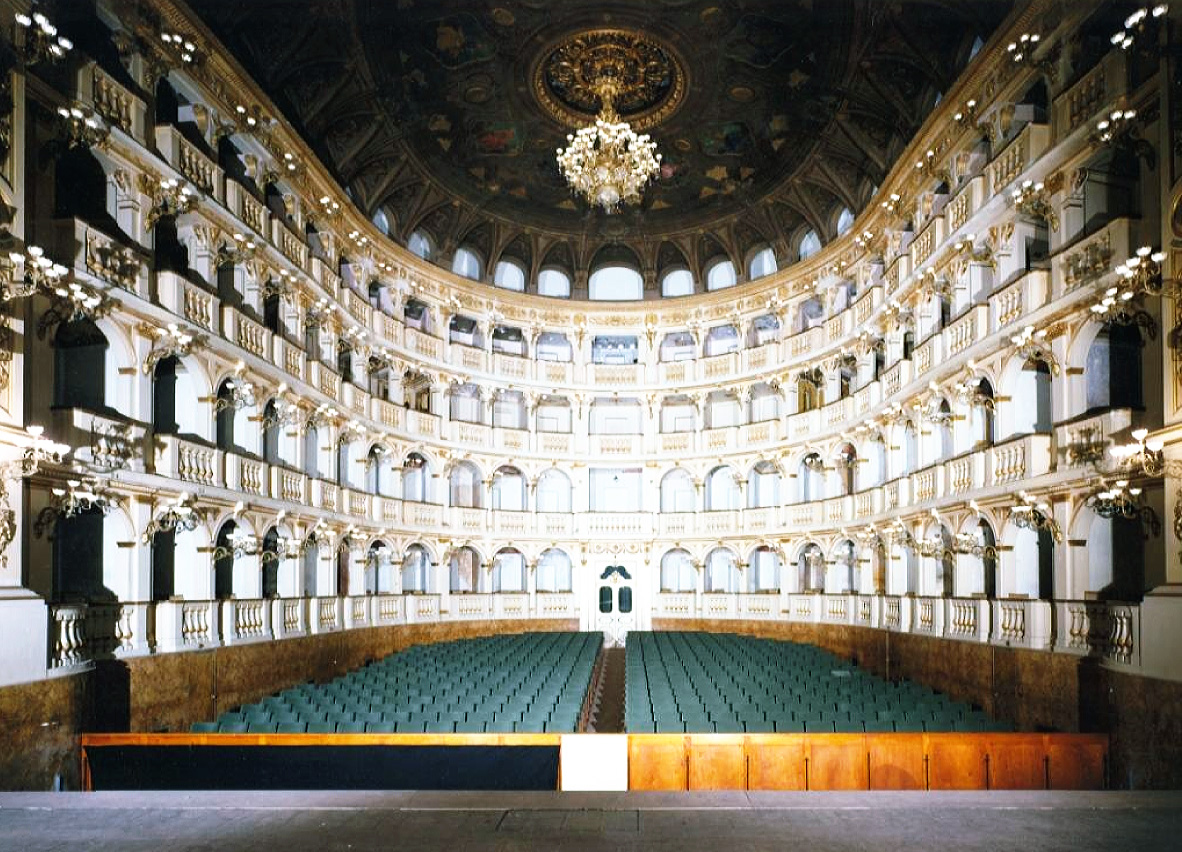 Municipal Theatre
Municipal Theatre
In 1756 the Senate of Bologna commissioned the famous architect and stage designer Antonio Galli Bibiena to design a new theatre. Galli Bibiena’s original design–surviving as a wooden model in the foyer of the theatre–was heavily criticized by the architects of the Accademia Clementina, whereupon its proportions were altered. The new theatre opened on 14 may 1763 with the first performance of the opera “Il Trionfo di Clelia” by Gluck, text by Metastasio, with stage sets by the very same Antonio Galli Bibiena. Over the next centuries bigger and smaller changes were executed concerning the camerini, i.e. small rooms behind the boxes, the walls of the stalls area, the portal, the painted ceiling (the current one dates from 1870) and the stage; the facade was completed only in 1935-36 by Umberto Ricci. But below the floor of the auditorium there is a wooden machinery from 1820 that can lift the whole floor to the level of the stage.
Teatro Comunale · Largo Respighi, 1 · 40126 Bologna · Tickets and information: +39 051 529958 (Tue-Fri 10:00-17:00) · Fax: +39 051 529995 · E-mail: boxoffice[at]comunalebologna.it · www.comunalebologna.it
Visits: guided tours are conducted on appointment by the Guide d'Arte G.A.I.A., tel.: 0039 348 4222070 (Mon-Fri 10:00-13:00) or guidateatro@libero.it
Tourist Office: Ufficio Informazione e Accoglienza Turistica
Tel.: +39 051 239660
TouristOffice[at]comune.bologna.it
www.bolognaturismo.info
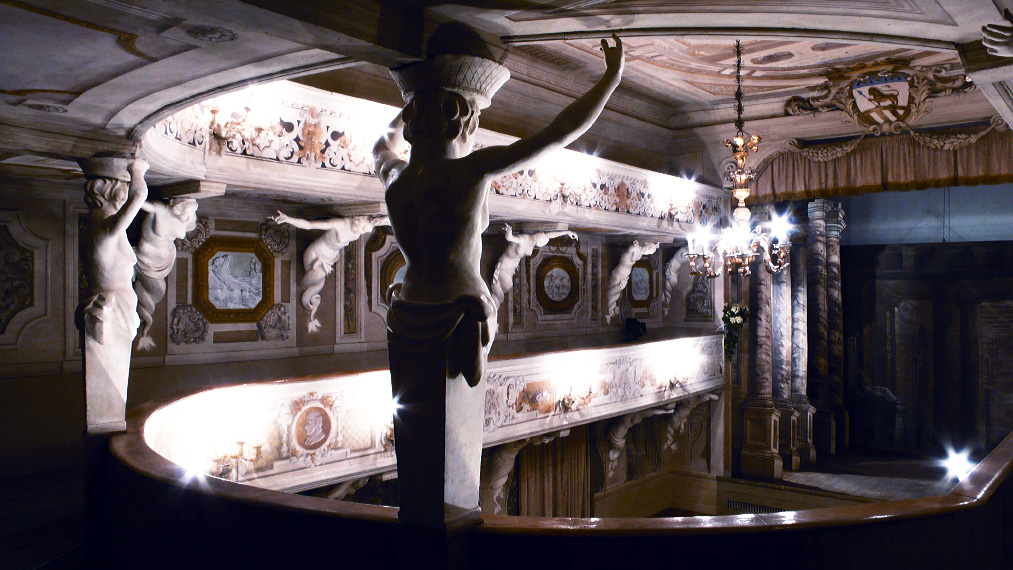 Teatro in the villa Aldrovandi Mazzacorati
Teatro in the villa Aldrovandi Mazzacorati
This intimate, originally preserved gem of a theatre in the left wing of a villa was created for the count and senator Giovan Francesco Aldrovandi who opened it on 14 September 1763, shortly after the inauguration of the Municipal Theatre. The refined decoration of the auditorium features delicious pastel frescoes on the walls and twenty tritons and caryatides who seem to carry the two balconies with their spiralling bodies. Depending on the occasion, they held garlands, lanterns or flowers in their hands. The theatre seats 80 spectators and is famous for its acoustics. For more than 15 years the non-profit association “Cultura e Arte del ’700” has been offering a rich season with drama and opera performances, concerts and lectures.
Teatro di Villa Aldrovandi Mazzacorati · via Toscana 17-19 · 40141 Bologna · Tel. and fax: +39 051 6235780 · E-mail: culturarte.700[at]gmail.com
Visits: every Thursday at 15:30, free of charge; for groups on appointment. Closed in August
Tourist Office:
Ufficio Informazione e Accoglienza Turistica
Tel.: +39 051 239660
TouristOffice[at]comune.bologna.it
www.bolognaturismo.info
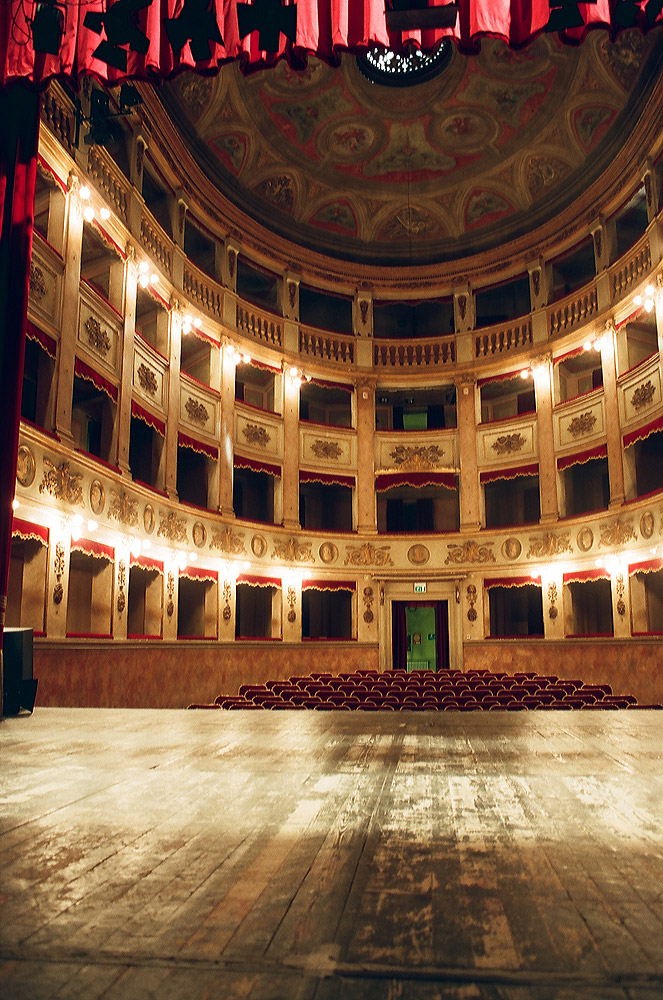 Municipal Theatre
Municipal Theatre
As early as 1626 the city council entrusted a big room in the town hall to the “Accademia dei Candidi Uniti” for performances of drama and opera. In 1659 the Academy had a stage and balconies with boxes constructed inside. When after a hundred years this construction had worn out, it was replaced by a new auditorium designed by the architect Giuseppe Tubertini in 1790. At this point the city took over the management of the venue and thus one of the oldest theatrical spaces in Italy became a municipal theatre.
The entrance area was created in 1850. In 1860 Andrea Pesci and Gaetano Lodi painted a new ceiling (medallions by Antonio Muzzi) in the auditorium in neoclassical style that mixes well with the classicism of the 18th century and the bas-reliefs by Antonio Tognetti in the dress circle and other elements of the 19th century. Today it serves mainly as a theatre for children, with occasional performances for adults.
Teatro Comunale Politeamma · Municipio (town hall) · Corso Italia, 72 · 40017 San Giovanni in Persiceto · Tel. box office: +39 051 825022 · Tel. office: +39 051 6812953 · E-mail: teatrocomunale[at]comunepersiceto.it · www.comunepersiceto.it/TTTXTE/index.htm
Visits: on appointment
Tourist Office:
Pro Loco
Tel.: +39 051 826839
info[at]proloco-persiceto.org
www.proloco-persiceto.org
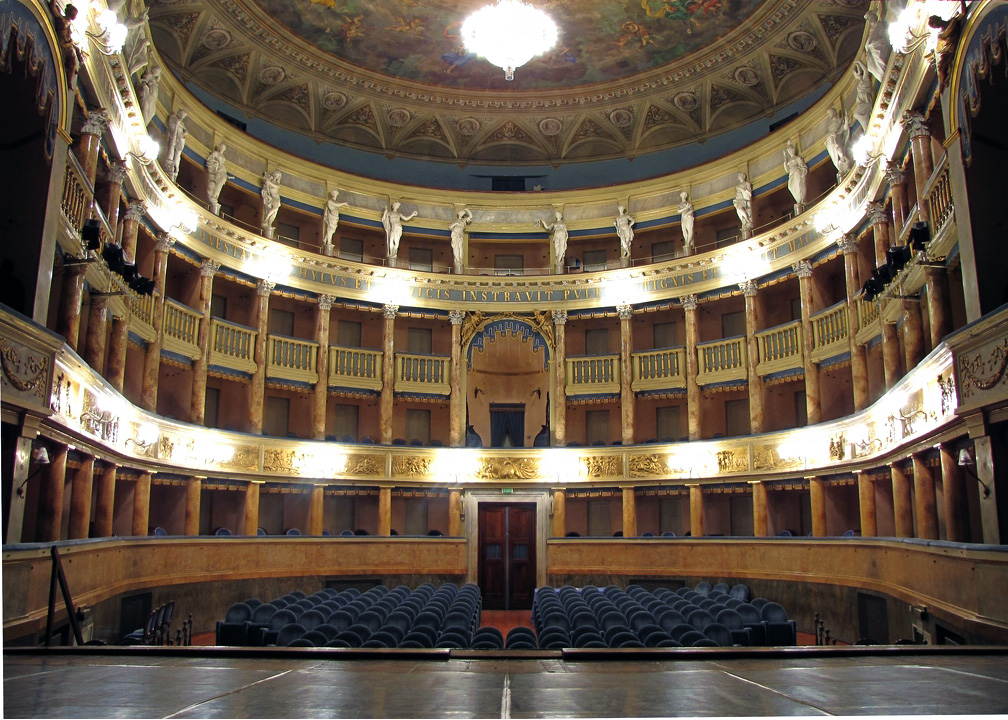 Municipal Theatre Masini
Municipal Theatre Masini
Near the main square, the Piazza del Popolo, the Municipal Theatre is hidden in a courtyard. Since 1903 it has been called after the tenor Angelo Masini who lived in Faenza until his death in 1926. The theatre, created in 1788 by the architect Giuseppe Pistocci for the “Accademia dei Rimoti”, is probably the only public theatre that does not turn its facade to the street; the main entrance behind row of columns is in the courtyard.
The auditorium, a masterpiece of neoclassicism in Italy, strives to create the impression of an open-air classical theatre, but this is combined here with the rows of boxes of the Italian opera house. The result is monumental and at the same time of a great variety. Special elements are the reliefs by Antonio Trentanove made of gilded terracotta (Faenza, the city of faïences!) and the remains of the 18th century stage machinery above the stage.
Teatro Comunale Masini · Piazza Nenni, 3 · 48018 Faenza (RA) · Tel.: +39 0546 691663 · E-mail: teatro.masini[at]comune.faenza.ra.it · www.teatromasini.org
Visits: on appointment, tel.: +39 0546 25231 (tourist information office)
Tourist Office:
Pro Loco
Tel.: +39 0546 25231
prolocofaenza[at]racine.ra.it
proxy.racine.ra.it/prolocofaenza
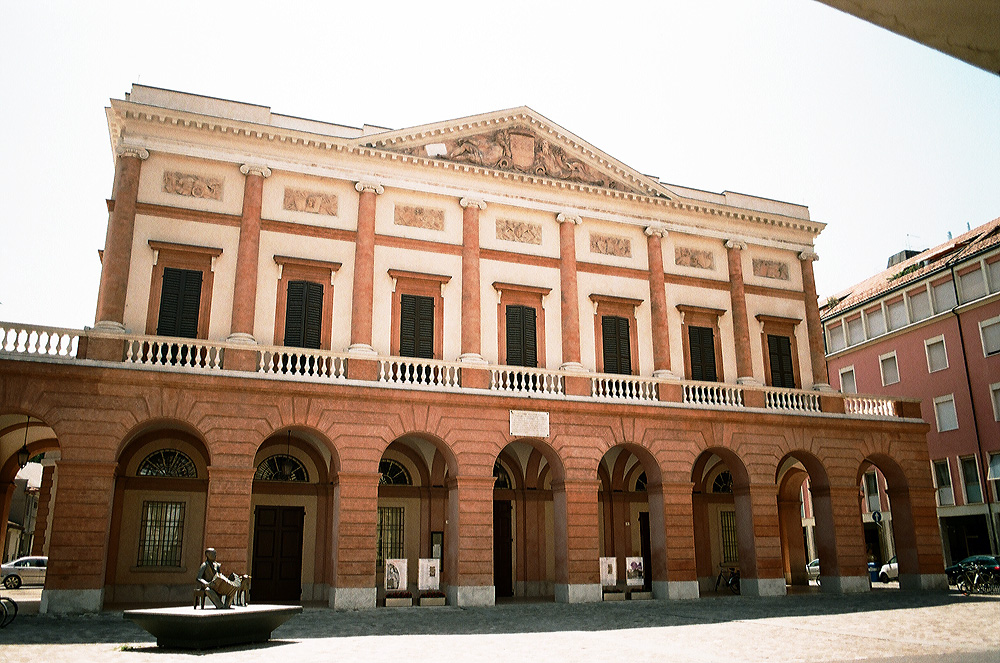 Bonci Theatre
Bonci Theatre
Built between 1843 and 1846 to plans of the architect Vincenzo Ghinelli, the theatre features a neoclassical facade in the style of Piermarini and an auditorium by Francesco Migliari for about 800 spectators. The stage is said to be one of the biggest in Europe. The original stage sets by pietro Venier from Verona and the painted curtain by the local artist Antonio Pio are preserved as well as the area above the stage with its drums and three sound machines. The numerous interventions that became necessary from 1846 till today have not visibly changed the original, with the exception, as everywhere, of the orchestra pit that was added in 1924 and cut back the stage. The theatre got its name in 1940 after the death of the tenor Alessandro Bonci who was born in Cesena.
Teatro Alessandro Bonci · Piazza Guidazzi, 9 · 47023 Cesena (FC) · Tel. box office: +39 0547 355959 · Tel. guardian: +39 0547 355911 · E-mail: ufficiocultura[at]teatrobonci.it · www.teatrobonci.it
Visits: on appointment, tel.: +39 0547 355724
Tourist Office:
Ufficio Informazione e Accoglienza Turistica
Tel.: +39 0547 356327
iat[at]comune.cesena.fc.it
www.comune.cesena.fc.it
The Italian Route |
The Italian Route of the "European Route of Historic Theatres" runs across Northern Italy, the only region in the world where one can follow the history of theatre from the Renaissance to the 19th century.
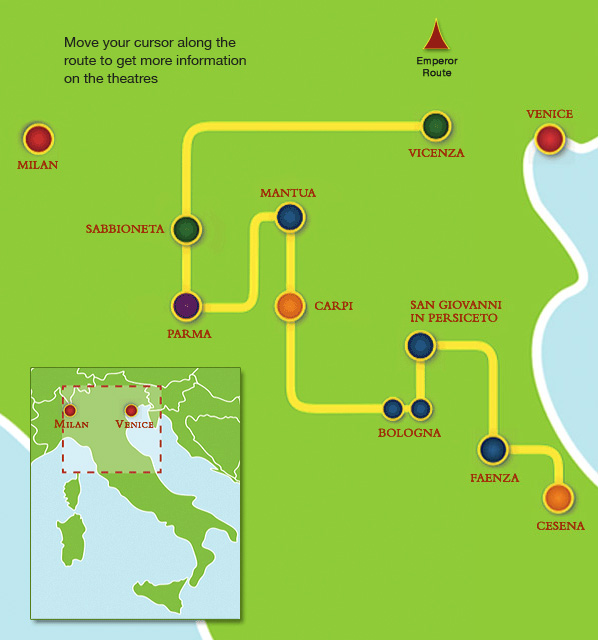
After the Medieval times when theatre performances had only been possible during religious festivities, the Renaissance rediscovered ancient Greek and Roman civilization and its worldly theatre. Academies were founded to study the sources and revive mostly Greek tragedies. So it does not come as a surprise that the oldest preserved theatre in Europe, the Teatro Olimpico in Vicenza, was commissioned by such an Academy. Here the architect Andrea Palladio transferred the model of the ancient Roman open-air theatre into a closed room. Vincenzo Scamozzi completed the theatre in 1585 and moved to Sabbioneta where he erected the first purpose-built theatre in Europe, the Teatro all’Antica (1590). Both theatres feature an open stage that does not allow to change the stage decoration. A portal behind which the scenery can be changed appears for the first time in the Teatro Farnese (1618) in Parma. Here the age of Baroque took off with its spectacular stage effects, while the auditorium still recalls an ancient theatre.
The first half of the 17th century saw a new theatric form: opera. And with it came a new kind of building: the opera house with many circles of boxes stacked up the wall, a form that has been influencing the way of building theatres till today. Since no theatres have been preserved from those days, the journey continues in the 18th century with another theatre for an Academy, the Teatro Scientifico in Mantua. It was built in 1767 by Antonio Galli Bibiena, scion of a famous family that built theatres everywhere in Europe for five generations. On the way to Bologna the perfectly preserved Teatro Comunale (1861) in Carpi allows a glimpse into the 19th century, before the journey through the 18th century continues in Bologna with the Teatro Comunale (1763), another oeuvre by Antonio Galli Bibiena. Besides public theatres, there were private theatres, for example in the villa Aldrovandi Mazzacorati, not far from Bologna’s city centre, where a real gem of a theatre dating from the same year can be found.
In 1790 the Teatro Comunale Politeama in the town hall of San Giovanni in Persiceto replaced an earlier theatre interior that had been constructed in the same hall for an Academy already in 1659. Like a twin brother, but still very different, appears the classicist auditorium of the Teatro Comunale Angelo Masini (1788) in Faenza. At the end of the tour, the Teatro Bonci (1846) in Cesena demonstrates again what an Italian-style theatre looked like in the middle of the 19th century.
With the support of the Culture Programme of the European Union

 Deutsch
Deutsch English
English Français
Français
